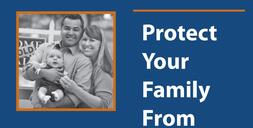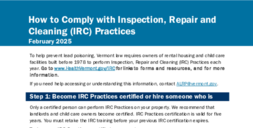Why IRC Practices are Required in Vermont
Lead is a highly toxic metal that was commonly used in paint, stain and varnish in homes built before 1978. Dust from lead-based paint is the major source of lead poisoning among children.
There is no safe level of lead in the body. Too much lead, or lead poisoning, can cause serious and permanent health problems for anyone. Babies, young children and pregnant people are at special risk. Lead poisoning can be prevented.
To help prevent lead poisoning, Vermont law requires owners of rental housing and child care facilities built before 1978 to perform Inspection, Repair and Cleaning (IRC) Practices each year.




